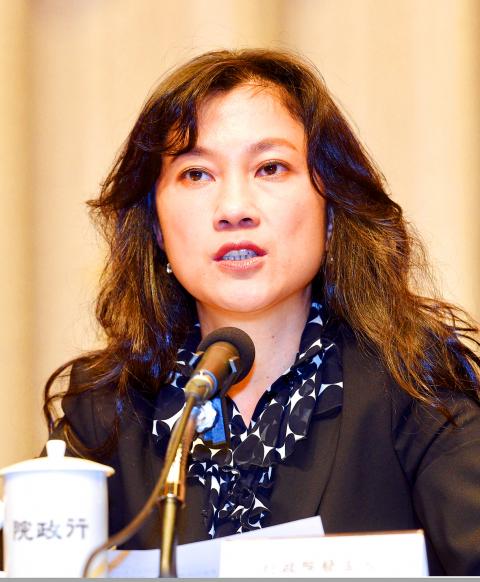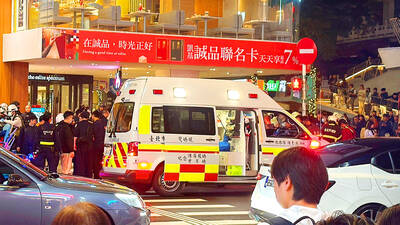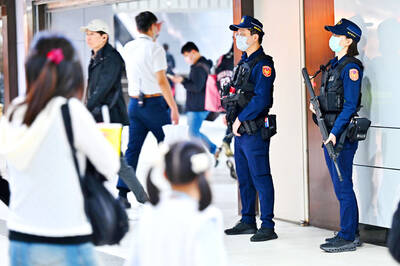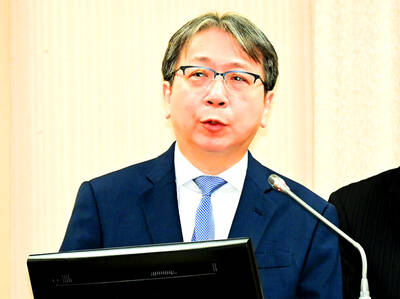The nation would no longer aim to become nuclear-free by 2025 in accordance with the result of Saturday’s referendum, Executive Yuan spokeswoman Kolas Yotaka said on Tuesday.
One of the 10 referendums Taiwanese voted on asked if they agreed that Article 95, Paragraph 1 of the Electricity Act (電業法), which calls for all nuclear power plants to stop running by 2025, should be abolished.
The results showed that 59.5 percent of the nearly 10 million people who voted are against abolishing nuclear power, Central Election Commission figures showed.

Photo: Peter Lo, Taipei Times
The Executive Yuan respects the result and would work with concerned ministries to re-evaluate the nation’s energy policies, Kolas said.
As such, the government would no longer regard 2025 as the deadline, she added.
After the 2011 Fukushima Dai-ichi nuclear power plant disaster in Japan, public opinion took a strong turn against nuclear energy, so the Democratic Progressive Party vowed to phase out nuclear power by 2025, Kolas said.
Although nuclear energy produces less air pollution, the problem of handling and storing nuclear waste remains a serious issue, she added.
The plan to realize a non-nuclear homeland would nevertheless remain the government’s goal for the foreseeable future, Kolas said.
Minister of Economic Affairs Shen Jong-chin (沈榮津) yesterday said that an updated national energy strategy would be formed in two months.
The Ministry of Economic Affairs has also instructed state-run Taiwan Power Co (台電) to submit a stay-of-decommissioning application for the Ma-anshan Nuclear Power Plant in Pingtung County’s Ma-anshan (馬鞍山) to the Atomic Energy Council before July, Shen told reporters on the sidelines of a question-and-answer session at the Legislative Yuan in Taipei.
Ma-anshan’s application is the most feasible, as there is still ample time before its original decommission date, he added.
As the schedule is much tighter for the Guosheng Nuclear Power Plant in New Taipei City’s Wanli District (萬里), a stay of decommissioning would only be considered when there is a power shortage, Shen said.
In keeping with voters’ wishes, the new strategy would prioritize renewable sources, energy conservation and nuclear power, Shen said.
However, the ministry would continue to work with the Executive Yuan to reach a consensus with those affected by the referendum’s outcome, he said, referring to opposition voiced by the Pingtung County Government.
Additional reporting by Ted Chen

TRAGEDY STRIKES TAIPEI: The suspect died after falling off a building after he threw smoke grenades into Taipei Main Station and went on a killing spree in Zhongshan A 27-year-old suspect allegedly threw smoke grenades in Taipei Main Station and then proceeded to Zhongshan MRT Station in a random killing spree that resulted in the death of the suspect and two other civilians, and seven injured, including one in critical condition, as of press time last night. The suspect, identified as a man surnamed Chang Wen (張文), allegedly began the attack at Taipei Main Station, the Taipei Fire Department said, adding that it received a report at 5:24pm that smoke grenades had been thrown in the station. One man in his 50s was rushed to hospital after a cardiac arrest

PUBLIC SAFETY: The premier said that security would be tightened in transport hubs, while President Lai commended the public for their bravery The government is to deploy more police, including rapid response units, in crowded public areas to ensure a swift response to any threats, President William Lai (賴清德) said yesterday after a knife attack killed three people and injured 11 in Taipei the previous day. Lai made the remarks following a briefing by the National Police Agency on the progress of the investigation, saying that the attack underscored the importance of cooperation in public security between the central and local governments. The attack unfolded in the early evening on Friday around Taipei Main Station’s M7 exit and later near the Taipei MRT’s Zhongshan

SAFETY FIRST: Double the number of police were deployed at the Taipei Marathon, while other cities released plans to bolster public event safety Authorities across Taiwan have stepped up security measures ahead of Christmas and New Year events, following a knife and smoke bomb attack in Taipei on Friday that left four people dead and 11 injured. In a bid to prevent potential copycat incidents, police deployments have been expanded for large gatherings, transport hubs, and other crowded public spaces, according to official statements from police and city authorities. Taipei Mayor Chiang Wan-an (蔣萬安) said the city has “comprehensively raised security readiness” in crowded areas, increased police deployments with armed officers, and intensified patrols during weekends and nighttime hours. For large-scale events, security checkpoints and explosives

ON ALERT: Taiwan’s partners would issue warnings if China attempted to use Interpol to target Taiwanese, and the global body has mechanisms to prevent it, an official said China has stationed two to four people specializing in Taiwan affairs at its embassies in several democratic countries to monitor and harass Taiwanese, actions that the host nations would not tolerate, National Security Bureau (NSB) Director-General Tsai Ming-yen (蔡明彥) said yesterday. Tsai made the comments at a meeting of the legislature’s Foreign Affairs and National Defense Committee, which asked him and Minister of National Defense Wellington Koo (顧立雄) to report on potential conflicts in the Taiwan Strait and military preparedness. Democratic Progressive Party (DPP) Legislator Michelle Lin (林楚茵) expressed concern that Beijing has posted personnel from China’s Taiwan Affairs Office to its